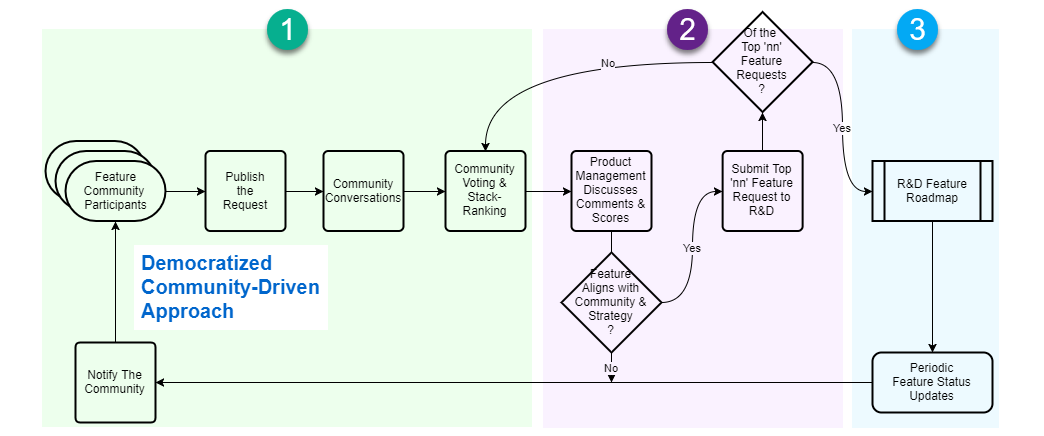Is your organization still treating ideas for product enhancement leveraging the same pipeline you use for bug reports, service requests, and feature questions?
Well then stop. There is a better way.
Not sure? No problem. In the banner image is a relatively generic diagram of how such a customer service-centric approach to feature requests might flow … along with a diagram a bit further down in the post.
If you’re still not entirely sure this is close to how your shop runs things, I’ve provided below five signs your organization might be suffering sub-optimal results based on the five flow silos I’ve numbered and color-coded above.
- Requests come in from multiple, individual sources, none of which connect, none of which encourage conversations among people encountering similar pain points.
- Triage of incoming requests is managed by hard-working people who may be incentivized to pass along an enhancement so they can spend more time on customer-related impediments and show-stoppers.
- Product management gets hopelessly sucked into numerous, swirling vortexes of ‘needs more information’ loops as a portion of the requests are entered without a use case, product context, or business value.
- Pressured by customers, sales, marketing, or the board, enhancements are sometimes stack-ranked by stakeholders whose product decisions are influenced by highly individualized, customer-specific promises needed to hit a sale or renewal goal rather than requests possessing more overall value to the entire enterprise.
- Updates to feature work in a separate system such as JIRA or VSTS aren’t communicated to customers tracking their requests through the customer service portal.
Loosening your Grip
If any or all of these scenarios sound familiar, then you may want to think about gaining control of your feature request process by letting go of these silos and democratizing the process. Below is an alternative flow to eliminate the silos while creating a community of collaboration:

I know what some of you are thinking “Yo Dean, are you nuts? You want to put the inmates in charge of the asylum?” Or perhaps — and with apologies to Henry Ford — “Don’t you know that if we ask people to collaborate on what they want, that they’ll vote for faster horses?”
I get it. I said the same things about 12 years ago. However since that time, the scales have fallen from my eyes, and I’m now one of the converted evangelizing for the democratization of feature requests for a variety of reasons. Here are three that correspond to the community-driven approach diagrammed above:
- Incoming ideas are immediately surfaced to the entire community, so they are usually stated with more context and business value. Moreover, other members of this community are equipped with the ability to vote or co-sponsor ideas. In this particular, we facilitated this through UserEcho.
- Product management and stakeholders are now in a better position to stack-rank or reject ideas based on the qualitative and quantitative data provided through community participation … or a lack thereof. In the case above, we employed an early variation of IDEA/E Prioritization.
- Development teams have more access the the ‘what’ and why driving a feature request. This in turn helps them gain empathy for requesters while considering better solutions that address the actual, underlying pain points. Here’s a good opportunity to employ collaborative tools such as MIRO.
What Others are Saying
If I’ve still not convinced you to consider democratizing your feature request process, then perhaps some of the discussions in the following half-dozen related blog posts and articles will:
- ‘Why “Yes” Doesn’t Scale’
- 3 Creative Ways To Manage Feature Requests (using Trello)
- How Product Managers Can Say No (and Still Get Invited to Lunch)
- A New Approach to Feature Requests — Signal v. Noise
- 10 Tips for Responding Graciously to Customer Feature Requests
- 12 Signs You’re Working in a Feature Factory
- Prioritization using IDEA/E — Steve Johnson
Useful Resources
For those of you who’d like to explore this community-driven approach to managing enhancement requests a bit more, below is a sextet of SaaS-based products that can help get you there:
- UserEcho
- Receptive.io
- UserResponse
- GetSatisfaction
- UserVoice
- Aha! Ideas Management
- MIRO
- NextPlease (in beta)
And if you’re working in organizations that have already liberated your feature request process from the constraints of a step-wise set of silos, I’d love to get your feedback in the comments below.
YMMV
